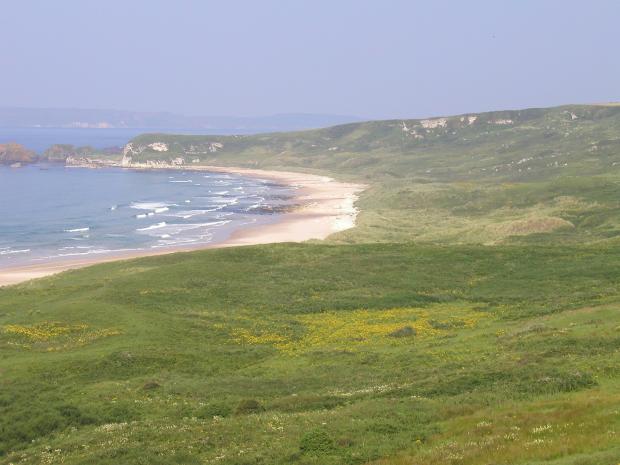
Situated on the north coast of Co. Antrim, White Park Bay faces north and lies between Port Braddan about 2 km east of Dunseverick Castle, and Dundriff a further 2 km to the east. The area covers 87.74 ha and extends some 400m inland, and has the mean low tide mark as its seaward boundary. The bay comprises a massive land-slipped area backed by high chalk cliffs. Several exposures are well represented, with sea-stacks and natural arches present. In addition, White Park Bay is notable for its diverse plant and animal communities, its largely, unmodified nature and the number of rare plants and animals recorded. Common lizard and Pygmy shrew are recorded from the site. Rabbits play an important role in grazing grassland areas. There have been occasional strandings of cetaceans, and grey seals sometimes haul out on off-shore rocks.
Birds using the cliffs for nesting include fulmar, house martin and swift. Cliffs in the past have been used by chough and buzzard. Sand martin nest in stream banks. Scrub areas are important for breeding passerines including whitethroat and grasshopper warbler. Jack snipe have been recorded from wet areas. Birds using the beach for nesting include ringed plover and oystercatcher. Eider congregate especially in the east of the bay.
White Park Bay is notable for its orchids. Eight species have been recorded, including Frog Orchid Coeloglossum viride, Pyramidal Orchid Anacamptis pyramidalis, Fragrant Orchid Gymnadenia conopsea, bee orchid and small-white orchid. Additional species of note include adder's-tongue and moonwort (two fern species), meadow crane's-bill, wood vetch, fragrant agrimony, smooth cat's-ear and thyme. The moss Rhodobryum roseum, which is rare in Ireland, is also of interest.
Species diversity amongst the Lepidoptera (butterflies and moths) is high with several rare or uncommon species. Thirteen butterfly species have been recorded, including the dark green fritillary, which is a typical duneland species in Northern Ireland but very local elsewhere, the common blue and small heath. The wood white butterfly, which is rare in Britain but locally frequent in Ireland, is also present. Amongst the moths, the six-spot burnet and Mother Shipton have been recorded. Solitary Hymenoptera (bees, wasps, ants, sawflies and parasitoid wasps) have also been studied, with Halictus rubicundus, Lasioglossum rufitarse (first record for Ireland) and Nomada bicolor among the species recorded.
Related articles
- ASSI Guidance for Public Bodies/Competent Authorities
- Coastal Areas of Special Scientific Interest
- Conservation Management Plans (CMPs)
- European Marine Sites - Marine Special Areas of Conservation and Special Protection Areas
- Introduction to Conservation Management Plans (CMPs) for Northern Ireland’s Special Areas of Conservation
- Marine Conservation Zones
- Marine Protected Areas
- Marine Ramsar sites
- Portrush Coastal Zone
- Special Areas of Conservation
- Special Areas of Conservation for Harbour porpoise
- Special Protection Areas
